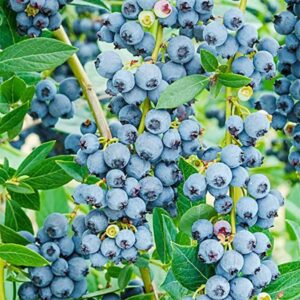Introduction: Embracing the Challenge of Growing Blueberries from Seed

As avid gardeners and plant enthusiasts, we often find ourselves drawn to the allure of growing our own produce from the ground up. The prospect of nurturing a plant from a tiny seed and watching it blossom into a thriving, fruit-bearing wonder is a truly rewarding experience. One such captivating challenge is the cultivation of blueberries, those plump, juicy berries that have become a beloved staple in many households.
While blueberries are widely available in grocery stores, the opportunity to grow them from seed presents a unique and gratifying journey. In this comprehensive guide, we will explore two proven methods for successfully sowing and germinating blueberry seeds, empowering you to embark on your own blueberry-growing adventure.
Method 1: Seed Extraction and Sowing
The first method we’ll delve into is the extraction and sowing of blueberry seeds. This approach requires a bit more hands-on work, but the rewards can be substantial.
Selecting the Perfect Blueberries
The key to successful seed extraction lies in choosing the right blueberries. It’s important to seek out the largest and most vibrant blueberries you can find. These berries are more likely to contain robust, viable seeds that will have a higher chance of germination.
Extracting the Seeds
Once you’ve selected your blueberries, it’s time to extract the seeds. This process involves the following steps:
- Add the blueberries to a container and cover them with water.
- Gently agitate the mixture to help break down the pulp and release the seeds.
- Allow the mixture to settle, and the heavier seeds will sink to the bottom.
- Carefully pour off the pulp and water, leaving the seeds behind.
- Repeat the rinsing process a few times to ensure all the pulp is removed.
- Spread the clean, dry seeds on a paper towel or napkin to finish drying.
By removing the pulp, you’re eliminating a potential source of competition for the seeds during the germination process. The pulp can attract fungi and microorganisms that may hinder the seeds’ ability to thrive.
Sowing the Seeds
With your clean, dry blueberry seeds in hand, it’s time to sow them. Choose a well-draining, nutrient-rich potting mix or compost as your growing medium. Lightly moisten the soil, but avoid over-saturating it.
Gently scatter the seeds across the surface of the soil, taking care not to bury them too deeply. Blueberry seeds are quite small, so a light dusting of soil over the top is sufficient. The key is to ensure the seeds have good soil-to-seed contact, allowing them to absorb moisture and begin the germination process.
Cover the container with a lid or plastic wrap to maintain consistent moisture levels, and place it in a warm, well-lit area. Monitor the soil regularly, misting it lightly if it begins to dry out.
Method 2: Blueberry Slice Sowing
The second method involves sowing blueberry slices rather than extracting the seeds. This approach can be a bit more straightforward, but it does come with its own considerations.
Preparing the Blueberry Slices
For this method, you’ll want to select ripe, juicy blueberries and carefully slice them in half, lengthwise. The goal is to expose the seeds within the fruit, allowing them to come into direct contact with the soil.
It’s important to be gentle during the slicing process to avoid damaging the delicate seeds. Aim for clean, even cuts to maximize the surface area for the seeds to germinate.
Sowing the Blueberry Slices
Prepare your growing medium in the same way as the seed extraction method, using a well-draining, nutrient-rich potting mix or compost. Lightly moisten the soil, but avoid over-saturation.
Gently press the blueberry slices into the soil, ensuring they are in full contact with the growing medium. You can either leave them exposed on the surface or lightly cover them with a thin layer of soil, depending on your preference.
As with the seed extraction method, cover the container with a lid or plastic wrap to maintain consistent moisture levels, and place it in a warm, well-lit area. Monitor the soil regularly, misting it lightly if it begins to dry out.
Considerations for the Blueberry Slice Method
While the blueberry slice method can be a more straightforward approach, it does come with some potential drawbacks. There is a risk of increased fungal growth due to the presence of the sugary pulp left on the fruit.
To mitigate this issue, it’s essential to keep a close eye on the growing medium and be prepared to address any signs of fungal growth. Regular monitoring and, if necessary, gentle removal of any affected areas can help ensure the seeds have the best chance of germination and healthy growth.
Comparing the Two Methods
Both the seed extraction and blueberry slice methods have their advantages and disadvantages. Let’s take a closer look at how they stack up:
Seed Extraction Method
- Eliminates competition from the pulp, allowing the seeds to focus on germination and growth.
- Potentially results in a higher number of successful seedlings due to the lack of fungal competition.
- Requires more hands-on work and attention to detail during the seed extraction process.
- Allows for the opportunity to select the largest, most viable seeds for sowing.
Blueberry Slice Method
- Simpler and more straightforward, as it involves directly sowing the blueberry slices.
- Exposes the seeds to the natural environment within the fruit, potentially mimicking their natural germination process.
- Carries a higher risk of fungal growth due to the presence of the sugary pulp.
- May result in a lower overall germination rate compared to the seed extraction method.
Ultimately, the choice between the two methods will depend on your personal preferences, the resources available to you, and your willingness to invest the extra time and effort required for the seed extraction approach.
Optimizing Germination Conditions
Regardless of the method you choose, creating the ideal germination conditions is crucial for the success of your blueberry seedlings. Here are some key factors to consider:
Temperature and Lighting
Blueberry seeds thrive in warm, well-lit environments. Aim to maintain a consistent temperature between 70-85°F (21-29°C) and provide your seedlings with ample access to bright, indirect sunlight. If natural sunlight is limited, consider supplementing with a grow light to ensure your blueberry plants receive the necessary light for healthy growth.
Soil and Moisture
As mentioned earlier, a well-draining, nutrient-rich potting mix or compost is essential for blueberry seed germination. Ensure the soil is loose and aerated, allowing the delicate roots to easily penetrate and access the necessary moisture and nutrients.
Maintain consistent soil moisture, but avoid over-watering. The growing medium should be moist but not waterlogged. Regular misting or light watering can help maintain the ideal moisture levels throughout the germination process.
Humidity and Ventilation
Blueberry seeds thrive in a humid environment, so consider covering your growing containers with a lid or plastic wrap to help retain moisture. However, it’s important to also provide adequate ventilation to prevent the buildup of excess humidity, which can lead to fungal issues.
Periodically remove the lid or wrap to allow for air circulation, and be vigilant for any signs of mold or fungal growth. Addressing these issues promptly can help ensure the health and success of your blueberry seedlings.
Transplanting and Ongoing Care
As your blueberry seedlings begin to grow and develop, it will be time to consider the next steps in their journey. It’s important to transplant the young plants to larger containers or directly into the ground, allowing them to continue thriving and eventually produce a bountiful harvest.
Be sure to check out the additional resources, which cover topics such as the first transplant, growing raspberries, and more. These supplementary guides can provide valuable insights and help you navigate the various stages of blueberry cultivation.



